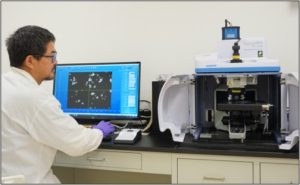Bight ’23 using newly standardized methods to analyze microplastics in sediment and shellfish

The Trash and Microplastics study element of the Southern California Bight 2023 Regional Monitoring Program is leveraging newly standardized methods for collecting and measuring microplastic particles to conduct a regional assessment of microplastics contamination in seafloor sediment and shellfish.
The Bight ’23 microplastics assessment, which kicked off in July, represents a dramatic step forward in how the Bight program collects, detects and quantifies microplastics – compared to a decade ago when the Bight program first conducted a regional survey of microplastics in sediment.
During Bight ’13, the smallest particles analyzed were 1 millimeter in size, and plastic type was determined via a float test plus reaction to treatment with various solvents. By contrast, Bight ’23 can analyze particles as small as 125 microns, and will use Fourier-transform infrared (FTIR) and Raman spectroscopy to determine material type.
A key focus of the Bight ’23 microplastics assessment will be investigating how microplastics can potentially be transported from land-based sources into the ocean; researchers are collecting sediment samples from embayments, marinas, ports and the inner shelf
The Bight ’23 regional survey will also help California realize its goal of building a statewide microplastics monitoring network for the coastal ocean.
More news related to: Emerging Contaminants, Regional Monitoring, Southern California Bight Regional Monitoring Program, Trash Pollution